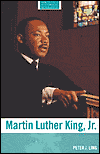

 |
Peter J. Ling. Martin Luther King, Jr. New York: Routledge, 2002. 356 pages. ISBN: 0415216656. Reviewed by Stephen Angell for the Journal of Southern Religion.
With an abundance of sources and scholarship available on Martin Luther King, Jr., the author of a brief biography such as this one has to make some careful choices. Peter Ling, Senior Lecturer in American Studies at the University of Nottingham, has chosen to write a treatment of King that focuses on his life and times, much in the manner of celebrated King biographers Taylor Branch and David Garrow, whose work he gratefully acknowledges as an influence. In many respects, this book is more a history of the many parts of the civil rights movement that had close contact with King than it is a biography of King himself.
| "What emerges from Ling's treatment is largely an appreciative but critical appraisal of King's strategic positioning, of his decisions and actions in the public sphere" |
What emerges from Ling's treatment is largely an appreciative but critical appraisal of King's strategic positioning, of his decisions and actions in the public sphere. There is a measure of paradox in Ling's treatment of King. He finds King as most successful in the period of 1963 to 1965 when such campaigns as Birmingham, St. Augustine, and Selma helped to transform the nation's attitude and catalyzed the passage of important legislation, but notes that King's success was most dependent at that time on the work of others. Conversely, his public activity from 1965 to 1968 was far less successful, but more heroic, in Ling's view, because his calling to a prophetic ministry propelled him to take controversial stands to work for an end to poverty and an end to the Vietnam War, even as King was fully aware that his stands would be unpopular. Ling finds a great deal of meaning in Ella Baker's dictum that "Martin did not make the movement, but the movement made Martin," but adds an important stipulation that the countermovement, both in Southern cities such as Birmingham and in the North's Chicago, also helped to fashion Martin. He thinks that the city officials during the Montgomery bus boycott constituted the first such instance, but far from the last.
Overall, this kind of treatment may undervalue certain of King's strengths – for instance, the way that his unprecedented ability to help the media focus national attention on injustice and oppression wherever he chose to campaign against it. However, it does highlight appropriately the manifold human qualities that King brought to his public actions: not only his courage, but also sometimes hesitance or vacillation; not only his mastery of applying Biblical metaphor to current injustices, but his personal need occasionally to shed his public persona – a need that underlay not only his commitment to his family but also the extramarital involvements that J. Edgar Hoover ruthlessly exploited against him. King's humor emerges in several of the anecdotes in this book. For example, after having been subjected to his friend Ralph Abernathy's snoring in a jail cell, King prayed at a subsequent fundraiser (with Abernathy present) that "Let me be sure to be arrested with people who don't snore"(111). In short, Ling's well-informed portrait of King is characterized by subtlety, sensitivity, complexity, and believability.
Unfortunately, Ling does not devote much attention to the issue of religion in the Civil Rights movement, which probably results from the hard choices that the brevity of his project forced him to make. King's warm upbringing in his father's Baptist church and the intellectual quest that resulted in his receiving a Ph.D. in religion from Boston University by age twenty-five are both well described. Ling gives a brief sketch of the constellation of black churches and preachers in Montgomery, Alabama, at the inception of the bus boycott in 1955.
After that historical moment, the attention that Ling gives to religion in King's biography declines markedly. Ling does impart a sense of King's Social Gospel convictions and the moral underpinnings of his many campaigns. He also gives a close reading of a few of King's most important speeches, and in so doing he does not ignore the religious imagery. However, Ling provides little light on his work as a minister or preacher (other than his work as a preacher to the world through the Southern Christian Leadership Conference), and he does not include any substantive discussion of King's ecclesiastical commitments or arguments. His disagreements with Joseph H. Jackson, for example, leading to the formation of the Progressive National Baptist Convention in 1961, are only subject to an allusion in a single subordinate clause. One would be well advised to consult such additional resources as John Ansbro, Lewis V. Baldwin, Baldwin and Amiri YaSin Al-Hadid, Taylor Branch, Clayborne Carson, James H. Cone, Richard Lischer, and Kenneth L. Smith and Ira G. Zepp for more thorough treatments of King's religion, especially during the height of his public leadership from 1955 to 1968.
In conclusion, Ling presents a very informative and helpful portrait of King's public career as a civil rights leader, but readers for whom King's religion is a primary matter of concern may be disappointed at the lack of attention Ling gives to this subject.
Stephen Angell,
© 1998-2004 by The Journal of Southern Religion. All rights reserved. ISSN 1094-5234